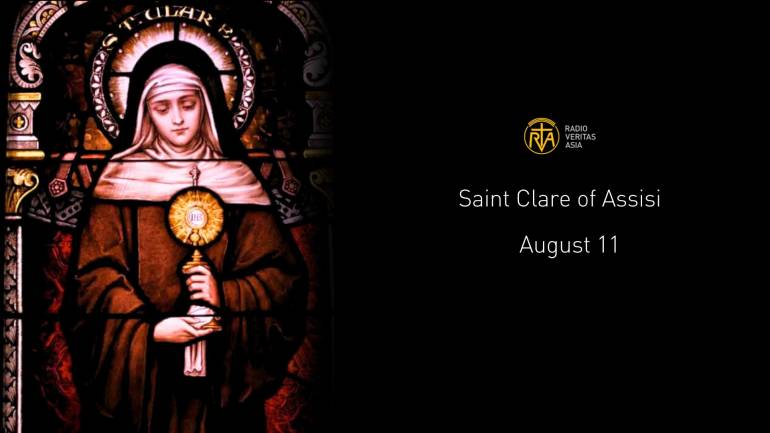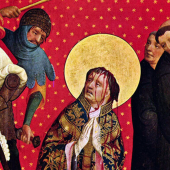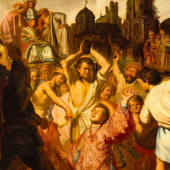When the Eucharist Drove Armies Away – The Miracle of Saint Clare

Near Assisi, Italy, stood the 12th-century convent of San Damiano, built by Saint Francis of Assisi after receiving a heavenly vision from Christ. It was the first monastery of the Order of Saint Clare and the silent witness to a remarkable Eucharistic miracle.
In September 1240, during the Crusades, the convent was attacked by Saracen armies. Clare, the abbess, repelled them not with weapons or military strategy, but with unwavering trust in God and fervent prayer. Amid the shouts and blasphemies of the attackers, she took the monstrance from the tabernacle and raised it from the refectory window. She prayed: “Lord, do not hand over Your handmaids, consecrated to Your love, into the hands of these beasts!” Upon seeing the Holy Eucharist, the Saracens fled, and the convent was spared.
This miracle was God’s work through His devoted servant Clare, whose love for the Eucharist surpassed all else.
From her earliest years, Clare was deeply in love with Christ. Born in 1194 into one of the wealthiest families in Italy, she longed to live in service, free from the trappings of wealth. At 15, she refused marriage to reserve her heart for the Lord. On Palm Sunday evening in 1211, she fled her home and sought refuge in a Franciscan chapel. There, Saint Francis of Assisi cut her golden hair, and she pledged herself to a life of holiness. Through her, the Franciscan movement gained its Second Order, the Poor Clares. She became abbess at the age of 21, a role she held until her death.
Living a secluded and austere life according to the Franciscan Rule, Clare found her greatest joy in adoring the Blessed Sacrament. She spent hours gazing upon the Lord in the Holy Eucharist, silently offering her gratitude and petitions. The miracle during the Saracen attack became a visible sign of her steadfast discipleship to Christ in the Eucharist.
Clare’s love for God overflowed into service. Despite her position as abbess, she performed daily chores and washed the feet of her sisters. She went barefoot, slept on the ground, and abstained from meat all year, practices her community embraced. Their life of radical poverty so concerned Pope Gregory IX that he urged her to moderate it. Clare replied, “I need to be absolved from my sins, but I do not wish to be absolved from the obligation of following Jesus Christ.” Moved by her conviction, the pope granted the Privilegium Paupertatis, allowing the sisters to live a life of radical poverty, owning nothing.
Pope Benedict XVI later noted that Clare was the first woman in Church history to write a Rule of Life and submit it to the pope for approval, proof, he said in 2010, that “even in the Middle Ages, the role of women was not secondary, but truly significant.”
In her final years, Clare suffered from serious illness. She died on August 11, 1253, at the age of 59. So great was her influence that Pope Alexander IV canonized her only two years later. In his canonization bull, he wrote: “How powerful was the illumination of this light, and how strong the brightness of this source of light! Truly, this light was hidden within the cloister, yet shone beyond with gleaming rays. Clare lay hidden, yet her life was revealed to all. Clare was silent, yet her fame resounded.”
Saint Clare’s life was firmly rooted in her love for the Eucharist, from which blossomed her humility, obedience, and charity. She never left the walls of San Damiano after embracing monastic life, yet her light reached far beyond, making her a shining jewel in God’s garden.
In her testament, she wrote: “Let the love you have in your hearts be shown outwardly in your deeds.” As we receive Christ in the Eucharist, may we, too, extend our hands and open our hearts to others, following the example of Saint Clare, who teaches us to be extraordinary by being steadfastly faithful in the ordinary.
Radio Veritas Asia (RVA), a media platform of the Catholic Church, aims to share Christ. RVA started in 1969 as a continental Catholic radio station to serve Asian countries in their respective local language, thus earning the tag “the Voice of Asian Christianity.” Responding to the emerging context, RVA embraced media platforms to connect with the global Asian audience via its 21 language websites and various social media platforms.














